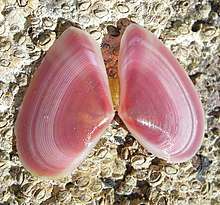Eurytellina simulans
| Eurytellina simulans | |
|---|---|
 | |
| Scientific classification | |
| Kingdom: | Animalia |
| Phylum: | Mollusca |
| Class: | Bivalvia |
| Order: | Veneroida |
| Family: | Tellinidae |
| Genus: | Eurytellina |
| Species: | E. simulans |
| Binomial name | |
| Eurytellina simulans Charles Baker Adams, 1852 | |
| Synonyms | |
|
Tellina simulans | |

Eurytellina simulans[1] is a species of bivalve mollusk. This species was previously known as Tellina simulans.[2]. The animal was originally described to science by naturalist Charles Baker Adams, a professor of zoology at Amherst College. Adams left for an expedition to Panama in mid-November 1850. He collected furiously upon arrival and on January 3, 1851 shipped eight crates back to Massachusetts. These contained 41,830 specimens of 516 species of mollusks[3]. He described Tellina simulans on the basis of a single valve.[3]
Description
The rose-red shells can reach 45 mm (1.8") long and 11mm (.4") in depth. The valves are connected by a short, prominent ligament. Lateral teeth are small or nonexistent. The valves are concentrically sculpted and more sharply triangular in cross-section than a similar Tellin, Eurytellina rubescens. Another difference between these two closely related species is that the pallial sinus does not touch the anterior adductor scar in E. simulans, while it does in E. rubescens.[4]
Distribution and life history
These tellins live in the Eastern Pacific from Scammon's Lagoon, Baja California Sur, Mexico to Peru, including the Gulf of California. They live buried in sand and mud from the intertidal zone to 24 meters (78') deep.[4] Like the rest of the tellins, they are filter feeders. They extend siphons up through the sand in order to breathe, strain nutrients from the water, spawn, and to excrete waste products.
References
- ↑ "WoRMS - World Register of Marine Species - Eurytellina simulans (C. B. Adams, 1852)". www.marinespecies.org. Retrieved 2018-07-06.
- ↑ Coan and Valentich-Scott (2012). Bivalve seashells of tropical West America. Marine bivalve mollusks from Baja California to northern Peru. Santa Barbara, California: Santa Barbara Museum of Natural History. ISBN 978-0-936494-43-2.
- 1 2 Adams, Charles Baker (1852). Catalog of Shells Collected at Panama. New York: R. Craighead. pp. 23 and 284-285.
- 1 2 Keen, A. Myra (1958). Sea Shells of Tropical West America. Stanford, California: Stanford University Press. p. 168.
External Links
C. B. Adam's 1852 book, in which he first described the animal is available on-line: https://archive.org/details/catalogueofshell00adam